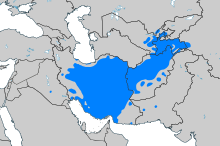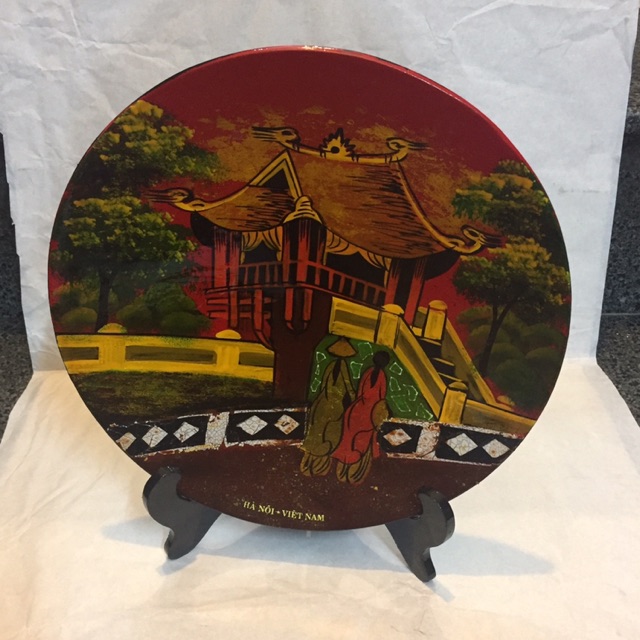Tiếng Ba Tư
Bài viết hoặc đoạn này cần người am hiểu về chủ đề này trợ giúp biên tập mở rộng hoặc cải thiện. (tháng 2/2022) |
| Tiếng Ba Tư | |
|---|---|
| Fārsi | |
| فارسی | |
 Fārsi viết bằng chữ Ba Tư-Ả Rập | |
| Phát âm | [fɒːɾˈsiː] |
| Sử dụng tại |
|
| Tổng số người nói | 45 triệu (2007)[6] – 60 triệu (2009)[5] người bản ngữ Tổng cộng 110 triệu.[5] |
| Phân loại | Ấn-Âu |
| Ngôn ngữ tiền thân | Tiếng Ba Tư cổ
|
| Dạng chuẩn | |
| Phương ngữ | |
| Hệ chữ viết |
|
| Địa vị chính thức | |
Ngôn ngữ chính thức tại | |
| Quy định bởi |
|
| Mã ngôn ngữ | |
| ISO 639-1 | fa |
| per (B) fas (T) | |
| ISO 639-3 | tùy trường hợp:pes – Tiếng Tây Ba Tưprs – Tiếng Dari (Ba Tư Afghan)tgk – Tiếng Tajikaiq – Phương ngữ Aimaqbhh – Phương ngữ Bukhorahaz – Phương ngữ Hazarajpr – Tiếng Ba Tư Do Tháiphv – Phương ngữ Pahlavandeh – Tiếng Dehwarjdt – Tiếng Tat Do Tháittt – Tiếng Tat (Kavkaz) |
| Glottolog | fars1255[7] |
| Linguasphere | |
 Khu vực nơi có số người nói Ba Tư đáng kể (tính cả phương ngữ). | |
 Các quốc gia nơi tiếng Ba Tư là ngôn ngữ chính thức. | |
Tiếng Ba Tư hay tiếng Persia, còn được biết đến như tiếng Farsi (فارسی fārsi [fɒːɾˈsiː] ⓘ), là một ngôn ngữ Iran thuộc ngữ tộc Ấn-Iran của hệ ngôn ngữ Ấn-Âu. Nó chủ yếu được nói ở Iran, Afghanistan (dưới tên gọi tiếng Dari từ năm 1958),[8] và Tajikistan (tên gọi tiếng Tajik vào thời Xô Viết ),[9] và một vài vùng khác về mặt lịch sử được xem là thuộc đế quốc Ba Tư. Tiếng Ba Tư, nói chung, được viết bằng chữ Ba Tư, một biến thể của chữ Ả Rập.
Tiếng Ba Tư hiện đại là sự tiếp nối của tiếng Ba Tư trung đại, ngôn ngữ tôn giáo và văn học chính thức của Đế chế Sassanid, mà chính nó lại là hậu thân của tiếng Ba Tư cổ, ngôn ngữ của Đế chế Achaemenes.[10][11][12] Ngữ pháp của nó tương đồng với nhiều ngôn ngữ của châu Âu đương thời.[13]
Tiếng Dari của Afghani đã bị pha trộn rất nhiều với các ngôn ngữ như tiếng Mông Cổ.[14]
Có chừng 110 triệu người nói tiếng Ba Tư trên toàn cầu và ngôn ngữ này có vị thế chính thức tại Iran, Afghanistan, và Tajikistan. Trong nhiều thế kỷ, tiếng Ba Tư cũng là ngôn ngữ văn hóa tại nhiều vùng ở Tây Á, Trung Á, và Nam Á.[15]
Tiếng Ba Tư đã ảnh hưởng (chủ yếu về từ vựng) một cách đáng kể lên nhiều ngôn ngữ xung quanh, nhất là các ngôn ngữ Turk miền Trung Á, Kavkaz, và Tiểu Á, những ngôn ngữ Iran lân cận, cũng như tiếng Armenia, tiếng Gruzia, vài ngôn ngữ Ấn-Iran khác, đặc biệt là tiếng Urdu (một dạng tiếng Hindustan). Nó cũng ảnh hưởng phần nào lên tiếng Ả Rập, nổi bật nhất là ở tiếng Ả Rập Bahran.[16] Ngược lại, tiếng Ba Tư cũng mượn rất nhiều từ trong tiếng Ả Rập sau cuộc xâm lược Ba Tư của người Ả Rập.[10][13][17][18][19][20]
Nguồn gốc và phát triển
[sửa | sửa mã nguồn]Tiếng Ba Tư bắt nguồn từ tiếng Ba Tư cổ, ngôn ngữ của Đế chế Achaemenes (khoảng 550 - 330 TCN). Tiếng Ba Tư cổ được ghi chép bằng chữ viết Ba Tư cổ, một hệ thống chữ viết dựa trên chữ hình nêm. Sau khi Alexander Đại đế chinh phục Ba Tư, tiếng Hy Lạp bắt đầu ảnh hưởng đến tiếng Ba Tư cổ, dẫn đến sự hình thành tiếng Ba Tư trung đại, hay tiếng Pahlavi (khoảng 224 TCN - 651 SCN).
Tiếng Ba Tư trung đại được sử dụng dưới triều đại Sassanid (224 - 651 SCN) và trở thành ngôn ngữ chính thức của đế chế. Trong thời kỳ này, tiếng Ba Tư chịu ảnh hưởng từ tiếng Ả Rập, đặc biệt là sau cuộc xâm lược Hồi giáo vào thế kỷ thứ 7. Hệ thống chữ viết Ba Tư-Ả Rập được phát triển dựa trên chữ Ả Rập, thay thế cho chữ viết Pahlavi.
Tiếng Ba Tư hiện đại bắt đầu phát triển từ thế kỷ thứ 9 SCN. Ngôn ngữ này tiếp tục chịu ảnh hưởng từ tiếng Ả Rập, cũng như tiếng Thổ Nhĩ Kỳ và tiếng Mông Cổ. Tiếng Ba Tư hiện đại có nhiều phương ngữ khác nhau, được sử dụng ở Iran, Afghanistan, Tajikistan, Uzbekistan và một số quốc gia khác.
Chú thích
[sửa | sửa mã nguồn]- ^ a b c Samadi, Habibeh; Nick Perkins (2012). Martin Ball; David Crystal; Paul Fletcher (biên tập). Assessing Grammar: The Languages of Lars. Multilingual Matters. tr. 169. ISBN 978-1-84769-637-3.
- ^ “IRAQ”. Truy cập ngày 7 tháng 11 năm 2014.
- ^ Pilkington, Hilary; Yemelianova, Galina (2004). Islam in Post-Soviet Russia. Taylor & Francis. tr. 27. ISBN 978-0-203-21769-6.: "Among other indigenous peoples of Iranian origin were the Tats, the Talishes and the Kurds"
- ^ Mastyugina, Tatiana; Perepelkin, Lev (1996). An Ethnic History of Russia: Pre-revolutionary Times to the Present. Greenwood Publishing Group. ISBN 978-0-313-29315-3., p. 80: "The Iranian Peoples (Ossetians, Tajiks, Tats, Mountain Judaists)"
- ^ a b c d e f Windfuhr, Gernot: The Iranian Languages, Routledge 2009, p. 418.
- ^ Mikael Parkvall, "Världens 100 största språk 2007" (The World's 100 Largest Languages in 2007), in Nationalencyklopedin
- ^ Nordhoff, Sebastian; Hammarström, Harald; Forkel, Robert; Haspelmath, Martin biên tập (2013). “Farsic – Caucasian Tat”. Glottolog. Leipzig: Max Planck Institute for Evolutionary Anthropology.
- ^ Asta Olesen, "Islam and Politics in Afghanistan, Volume 3", Psychology Press, 1995. pg 205: "There began a general promotion of the Pashto language at the expense of Fārsi – previously dominant at the educational and administrative level – and the term 'Dari' for the Afghan version of Persian came into common use, being officially adopted in 1958"
- ^ Baker, Mona (2001). Routledge Encyclopedia of Translation Studies. Psychology Press. ISBN 978-0-415-25517-2., pg 518: "among them the realignment of Central Asian Persian, renamed Tajiki by the Soviet Union"
- ^ a b Lazard, Gilbert 1975, "The Rise of the New Persian Language" in Frye, R. N., The Cambridge History of Iran, Vol. 4, pp. 595–632, Cambridge: Cambridge University Press. "The language known as New Persian, which usually is called at this period (early Islamic times) by the name of Dari or Farsi-Dari, can be classified linguistically as a continuation of Middle Persian, the official religious and literary language of Sassanian Iran, itself a continuation of Old Persian, the language of the Achaemenids. Unlike the other languages and dialects, ancient and modern, of the Iranian group such as Avestan, Parthian, Soghdian, Kurdish, Balochi, Pashto, etc., Old Persian, Middle and New Persian represent one and the same language at three states of its history. It had its origin in Fars (the true Persian country from the historical point of view) and is differentiated by dialectical features, still easily recognizable from the dialect prevailing in north-western and eastern Iran."
- ^ Ulrich Ammon, Norbert Dittmar, Klaus J. Mattheier, Peter Trudgill, "Sociolinguistics Hsk 3/3 Series Volume 3 of Sociolinguistics: An International Handbook of the Science of Language and Society", Walter de Gruyter, 2006. 2nd edition. pg 1912. Excerpt: "Tiếng Ba Tư trung đại, còn được gọi là Pahlavi, là sự tiếp nối trực tiếp của tiếng Ba Tư cổ, và đã được dùng như ngôn ngữ viết chính thức quốc gia." "Tuy nhiên, sau cuộc xâm lược của người Hồi giáo và sự sụp đổ của nhà Sassanid, tiếng Pahlavi dần bị thay thế bởi Dari, bản thân cũng là một dạng của tiếng Ba Tư trung đại, với lượng từ mượn đáng kể từ tiếng Ả Rập và Parthia."
- ^ Skjærvø, Prods Oktor (2006). Encyclopedia Iranica, "Iran, vi. Iranian languages and scripts, "new Persian, is "the descendant of Middle Persian" and has since been "official language of Iranian states for centuries", whereas for other non-Persian Iranian languages "close genetic relationships are difficult to establish" between their different (Middle and Modern) stages. Modern Yaḡnōbi belongs to the same dialect group as Sogdian, but is not a direct descendant; Bactrian may be closely related to modern Yidḡa and Munji (Munjāni); and Wakhi (Wāḵi) belongs with Khotanese."
- ^ a b Richard Davis, "Persian" in Josef W. Meri, Jere L. Bacharach, "Medieval Islamic Civilization", Taylor & Francis, 2006. pp. 602–603. "The grammar of New Persian is similar to many contemporary European languages."Similarly, the core vocabulary of Persian continued to be derived from Pahlavi.
- ^ https://www.dailymirror.lk/print/opinion/Collective-resolve-of-regional-and-international-actors-a-glimmer-of-hope-for-Afghans-Air-Chief-Marshal-Bulathsinghala/172-282040
- ^ Encyclopædia Britannica: Persian literature, retrieved September 2011.
- ^ Holes, Clive (2001). Dialect, Culture, and Society in Eastern Arabia: Glossary. BRILL. ISBN 90-04-10763-0., p. XXX
- ^ Lazard, Gilbert, "Pahlavi, Pârsi, dari: Les langues d'Iran d'apès Ibn al-Muqaffa" in R.N. Frye, Iran and Islam. In Memory of the late Vladimir Minorsky, Edinburgh University Press, 1971.
- ^ Nushin Namazi (ngày 24 tháng 11 năm 2008). “Persian Loan Words in Arabic”. Bản gốc lưu trữ ngày 20 tháng 5 năm 2011. Truy cập ngày 1 tháng 6 năm 2009.
- ^ Classe, Olive (2000). Encyclopedia of literary translation into English. Taylor & Francis. tr. 1057. ISBN 1-884964-36-2.
Since the Arab conquest of the country in 7th century AD, many loan words have entered the language (which from this time has been written with a slightly modified version of the Arabic script) and the literature has been heavily influenced by the conventions of Arabic literature.
- ^ Ann K. S. Lambton, Persian grammar, Cambridge University Press 1953. "The Arabic words incorporated into the Persian language have become Persianized".
Liên kết ngoài
[sửa | sửa mã nguồn]| Từ điển từ Wiktionary | |
| Tập tin phương tiện từ Commons | |
| Danh ngôn từ Wikiquote | |
| Cẩm nang du lịch guide từ Wikivoyage | |
- Academy of Persian Language and Literature official website Lưu trữ 2009-08-30 tại Wayback Machine (tiếng Ba Tư)
- Assembly for the Expansion of the Persian Language official website (tiếng Ba Tư)
- Persian language Resources Lưu trữ 2012-12-09 tại Wayback Machine (tiếng Ba Tư)
- Persian Language Resources, parstimes.com
- Haim, Soleiman. New Persian–English dictionary. Teheran: Librairie-imprimerie Beroukhim, 1934–1936. uchicago.edu
- Steingass, Francis Joseph. A Comprehensive Persian–English dictionary. London: Routledge & K. Paul, 1892. uchicago.edu
- UCLA Language Materials Project: Lưu trữ 2006-07-20 tại Wayback Machine Persian Lưu trữ 2017-09-23 tại Wayback Machine, ucla.edu
- How Persian Alphabet Transits into Graffiti, Persian Graffiti
- Basic Persian language course (book + audio files) USA Foreign Service Institute (FSI)
Đọc thêm
[sửa | sửa mã nguồn]- Asatrian, Garnik (2010). Etymological Dictionary of Persian. Leiden Indo-European Etymological Dictionary Series, 12. Brill Academic Publishers. ISBN 978-90-04-18341-4.
- Bleeck, Arthur Henry (1857). A concise grammar of the Persian language. Truy cập ngày 6 tháng 7 năm 2011.
- Bleeck, Arthur Henry (1857). A concise grammar of the Persian language: containing dialogues, reading lessons, and a vocabulary: together with a new plan for facilitating the study of languages. B. Quaritch. tr. 206. Truy cập ngày 6 tháng 7 năm 2011.
- Bleeck, Arthur Henry (1857). A concise grammar of the Persian language . Truy cập ngày 6 tháng 7 năm 2011.
- Dahlén, Ashk (tháng 4 năm 2014) [1st edition October 2010]. Modern persisk grammatik (ấn bản thứ 2). Ferdosi International Publication. ISBN 9789197988674. Bản gốc lưu trữ ngày 11 tháng 10 năm 2017. Truy cập ngày 10 tháng 3 năm 2016.
- Delshad, Farshid (tháng 9 năm 2007). Anthologia Persica. Logos Verlag. ISBN 978-3-8325-1620-8.
- Doctor, Sorabshaw Byramji (1880). The student's Persian and English dictionary, pronouncing, etymological, & explanatory. Irish Presbyterian Mission Press. tr. 558. Truy cập ngày 6 tháng 7 năm 2011.
- Doctor, Sorabshaw Byramji; Saʻdī (1880). Second book of Persian, to which are added the Pandnámah of Shaikh Saádi and the Gulistán, chapter 1, together with vocabulary and short notes (ấn bản thứ 2). Irish Presbyterian Mission Press. tr. 120. Truy cập ngày 6 tháng 7 năm 2011.
- Doctor, Sorabshaw Byramji (1879). The Persian primer, being an elementary treatise on grammar, with exercises. Irish Presbyterian Mission Press. tr. 94. Truy cập ngày 6 tháng 7 năm 2011.
- Doctor, Sorabshaw Byramji (1875). A new grammar of the Persian tongue for the use of schools and colleges. Irish Presbyterian Mission Press. tr. 84. Truy cập ngày 6 tháng 7 năm 2011.
- Forbes, Duncan (1844). A grammar of the Persian language: To which is added, a selection of easy extracts for reading, together with a copious vocabulary (ấn bản thứ 2). Printed for the author, sold by Allen & co. tr. 158. Truy cập ngày 6 tháng 7 năm 2011.
- Forbes, Duncan (1844). A grammar of the Persian language: To which is added, a selection of easy extracts for reading, together with a copious vocabulary (ấn bản thứ 2). Printed for the author, sold by Allen & co. tr. 114. Truy cập ngày 6 tháng 7 năm 2011.
- Forbes, Duncan (1876). A grammar of the Persian language: to which is added, a selection of easy extracts for reading, together with a vocabulary, and translations. W.H. Allen. tr. 238. Truy cập ngày 6 tháng 7 năm 2011.
- Forbes, Duncan (1869). A grammar of the Persian language: to which is added, a selection of easy extracts for reading, together with a vocabulary, and translations (ấn bản thứ 4). W.H. Allen & co. tr. 238. Truy cập ngày 6 tháng 7 năm 2011.
- Ibrâhîm, Muḥammad (1841). A grammar of the Persian language. Truy cập ngày 6 tháng 7 năm 2011.
- Jones, Sir William (1783). A grammar of the Persian language (ấn bản thứ 3). Truy cập ngày 6 tháng 7 năm 2011.
- Jones, Sir William (1797). A grammar of the Persian language (ấn bản thứ 4). Truy cập ngày 6 tháng 7 năm 2011.
- Jones, Sir William (1801). A grammar of the Persian language (ấn bản thứ 5). Murray and Highley, J. Sewell. tr. 194. Truy cập ngày 6 tháng 7 năm 2011.
- Jones, Sir William (1823). Samuel Lee (biên tập). A grammar of the Persian language (ấn bản thứ 8). Printed by W. Nicol, for Parbury, Allen, and co. tr. 230. Truy cập ngày 6 tháng 7 năm 2011.
- Jones, Sir William (1828). Samuel Lee (biên tập). A grammar of the Persian language (ấn bản thứ 9). Printed by W. Nicol, for Parbury, Allen, and Co. tr. 283. Truy cập ngày 6 tháng 7 năm 2011.
- Lazard, Gilbert (tháng 1 năm 2006). Grammaire du persan contemporain. Institut Français de Recherche en Iran. ISBN 978-2909961378. Bản gốc lưu trữ ngày 3 tháng 5 năm 2012. Truy cập ngày 10 tháng 3 năm 2016.
- Lumsden, Matthew (1810). A grammar of the Persian language; comprising a portion of the elements of Arabic inflexion etc. Watley. Truy cập ngày 6 tháng 7 năm 2011.
- Mace, John (ngày 18 tháng 10 năm 2002). Persian Grammar: For Reference and Revision . RoutledgeCurzon. ISBN 0700716955.
- Moises, Edward (1792). The Persian interpreter: in three parts: A grammar of the Persian language. Persian extracts, in prose and verse. A vocabulary: Persian and English. Printed by L. Hodgson. tr. 143. Truy cập ngày 6 tháng 7 năm 2011.
- Palmer, Edward Henry (1883). Guy Le Strange (biên tập). A concise dictionary, English-Persian; together with a simplified grammar of the Persian language. Completed and ed. by G. Le Strange. Truy cập ngày 6 tháng 7 năm 2011.
- Palmer, Edward Henry (1883). Guy Le Strange (biên tập). A concise dictionary, English-Persian: together with a simplified grammar of the Persian language. Trübner. tr. 42. Truy cập ngày 6 tháng 7 năm 2011.
- Platts, John Thompson (1894). A grammar of the Persian language... Williams and Norgate. Truy cập ngày 6 tháng 7 năm 2011.
- Ranking, George Speirs Alexander (1907). A primer of Persian: containing selections for reading and composition with the elements of syntax. The Claredon Press. tr. 72. Truy cập ngày 6 tháng 7 năm 2011.
- Richardson, John (1810). Sir Charles Wilkins, David Hopkins (biên tập). A vocabulary, Persian, Arabic, and English: abridged from the quarto edition of Richardson's dictionary. Printed for F. and C. Rivingson. tr. 643. Truy cập ngày 6 tháng 7 năm 2011.
- Rosen, Friedrich; Nāṣir al-Dīn Shāh (Shah of Iran) (1898). Modern Persian colloquial grammar: containing a short grammar, dialogues and extracts from Nasir-Eddin shah's diaries, tales, etc., and a vocabulary. Luzac & C.̊. tr. 400. Truy cập ngày 6 tháng 7 năm 2011.
- Schmitt, Rüdiger (1989). Compendium linguarum Iranicarum. L. Reichert. ISBN 3882264136.
- Sen, Ramdhun (1841). Madhub Chunder Sen (biên tập). A dictionary in Persian and English, with pronunciation (ed. by M.C. Sen) (ấn bản thứ 2). Truy cập ngày 6 tháng 7 năm 2011.
- Sen, Ramdhun (1829). A dictionary in Persian and English. Printed for the author at the Baptist Mission Press. tr. 226. Truy cập ngày 6 tháng 7 năm 2011.
- Sen, Ramdhun (1833). A dictionary in English and Persian. Printed at the Baptist Mission Press. tr. 276. Truy cập ngày 6 tháng 7 năm 2011.
- Sen, Ramdhun (1833). A dictionary in English and Persian. Truy cập ngày 6 tháng 7 năm 2011.
- Skjærvø, Prods Oktor (2006). “Iran, vi. Iranian languages and scripts”. Encyclopaedia Iranica. 13.
- Thackston, W. M. (ngày 1 tháng 5 năm 1993). An Introduction to Persian (ấn bản thứ 3). Ibex Publishers. ISBN 0936347295.
- Tucker, William Thornhill (1801). A pocket dictionary of English and Persian. Truy cập ngày 6 tháng 7 năm 2011.
- Tucker, William Thornhill (1850). A pocket dictionary of English and Persian. J. Madden. tr. 145. Truy cập ngày 6 tháng 7 năm 2011.
- Tucker, William Thornhill (1850). A pocket dictionary of English and Persian. J. Madden. tr. 145. Truy cập ngày 6 tháng 7 năm 2011.
- Windfuhr, Gernot L. (ngày 15 tháng 1 năm 2009). “Persian”. Trong Bernard Comrie (biên tập). The World's Major Languages (ấn bản thứ 2). Routledge. ISBN 0415353394.
- Wollaston, (Sir) Arthur Naylor (1882). An English-Persian dictionary. W.H. Allen. Truy cập ngày 6 tháng 7 năm 2011.
Liên kết ngoài
[sửa | sửa mã nguồn] GIẢM
25%
GIẢM
25%
![[Review sách] Atomic Habits - Hiểu đúng về thói quen](https://down-bs-vn.img.susercontent.com/sg-11134201-22110-rq2ijer9fyjv18.webp) GIẢM
26%
GIẢM
26%
 GIẢM
26%
GIẢM
26%
 GIẢM
21%
GIẢM
21%
 GIẢM
40%
GIẢM
40%




